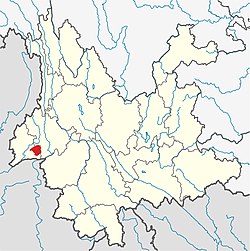The Chiefdom of Mangshi, officially Mangshi Yuyi Zhangguansi and Mangshi Anfusi was a Dai autonomous Tusi chiefdom in the west of Yunnan, China from 1443 to 1955. In 1443, the Ming dynasty established Mangshi Yuyi Zhangguansi (芒市御夷长官司) because a Mangshi chief made a contribution in Luchuan–Pingmian campaigns, and then upgraded to Mangshi Anfusi (芒市安抚司) in 1640. Chiefdom of Mangshi has an absolute dictatorship in politics, military, economy at the territory, and use the rule of primogeniture.[1]
Chiefdom of Mangshi 芒市土司 | |||||||||
|---|---|---|---|---|---|---|---|---|---|
| 1443–1955 | |||||||||
 Territory in modern Yunnan | |||||||||
| Status | Native Chiefdom of China | ||||||||
| Capital | Mangshi | ||||||||
| Common languages | Tai Nuea language | ||||||||
| Government | Monarchy | ||||||||
| Tusi | |||||||||
• 1443–1459 | Fang Dingzheng (first) | ||||||||
• 1948–1955 | Fang Yulong (last) | ||||||||
| History | |||||||||
• Established | 1443 | ||||||||
• Disestablished | 1955 | ||||||||
| |||||||||
| Today part of | China | ||||||||
In the Republic of China period, the central government used many methods try to abolish the Chiefdom of Mangshi, for example, established a direct control government "Luxi Administrate Bureau" (潞西设治局).[1] But the Chiefdom of Mangshi allied with other chiefdoms to counteract the abolishment. At its worst, chiefdoms had a consideration for independence from China. Finally, the central government compromised with chiefdoms.[2]
After People's Republic of China controlled this area, the central government launched the Chinese Land Reform Movement. The last Chief of Mangshi, Fang Yulong lost his power and land, finally abolished in 1955.[3]
Saophas
edit- Fang Tueng Kyeng 放定正 1443-1459 1st saopha
- Vacant 1459-1465
- Fang Kyen Hpa 放贞法 1465-1487 son
- Vacant 1487-1506
- Fang Goe Hpa 放革法 1506-1518 son
- Vacant 1518-1523
- Fang Fu Hpa 放辅法 (放福) 1523-1573 son
- Fang Kawn Hpa 放高恩法 1573-1591 son (kill in 1591 due to Yue Feng revolution)
- Fang Wei Hpa 放纬法 1592-1595 son, object by Lui Dadao 刘大刀 (刘𬘩) general of Ming Dynasty
- Vacant 1595-1596
- Fang Phon Hpa 放珀法 1596-1639 son
- Vacant 1639-1640
- Fang Htim Hpa 放蒂姆法 1640-1647 son (kidnapped by the Burmese military in 1647)
- Vacant 1647-1648
- Fang Hkuen Hpa 放库恩法 1648-1658 son
- Vacant 1658-1661
- Fang Oung Hpa 放昂法 1661-1664 son
- Vacant 1664-1668
- Fang Hting Ting 放田婷 1668-1673 younger brother
- Fang Hmi Kaeo 放弥高 1673-1685 son of Fang Oung Hpa
- Fang Hmi Hkoeng 放弥恒 1685-1694 younger brother
- Vacant 1694-1696
- Fang Htiew Hpa 放蒂奥法 1696-1713 son
- Vacant 1713-1716
- Fang Young Hpa 放杨法 1716-1738 first son
- Vacant 1738-1741
- Fang Sow Hpa 1741-1770 放作法 son 1st
- Vacant 1770-1771
- Fang Ngoen Chang 1771-1772 放愈彰 son (suicided himself by hanged)
- Fang Sow Hpa 放作法 1772-1774 2nd
- Fang Kou Hpa 放顾法 1774-1796 second son
- Vacant 1796-1798
- Fang Htiet Hpa 放蒂特法 1798-1816 son
- Fang Ngin Hpa 放愈新法 1816-1821 son killed by the revolt
- Fang Hsen Hpa 放森法 1821-1826 cousin
- Fang Ngun Hpa 放顏畝法 1826-1849 first son
- Fang Ab Hpa 放奧布法 1849-1858 younger brother
- Vacant 1858-1875
- Fang Lik Hpa 放力克法 1875-1877 first son of Fang Ab Hpa
- Vacant 1877-1879
- Fang Zho Hpa 放趙法 1879-1889 uncle
- Fang Yong Hpa 放雍法 1889-1889 younger brother
- Fang Zhang Nyue 放張野 1889-1910 son of Fang Lue Hpa
- Fang Hkoe Meng 方克猛 1910-1931 son
- Vacant 1931-1933
- Fang Youn Löng 方云龍 1933-1936 son
- Fang Hkang Hpa 方康法 1936-1953 third son of Fang Zhang Nyue
- Fang Hkoeng Hpa 方孔法 1944-1948 fourth son of Fang Zhang Nyue (became saopha of Mongmao)
- Fang Ein Löng 方御龍 1948-1955 (became saopha with Fang Hwe Löng during 1953-1955) fifth son of Fang Zhang Nyue
- Fang Hkoe Löng 方克龍 1953-1955 (last saopha) younger brother
References
edit- ^ a b 云南省潞西县志编纂委员会 (1993). 潞西县志 [Annals of Luxi County] (in Chinese). Kunming: Yunnan Education Publishing House. ISBN 7-5415-0685-0.
- ^ 王春桥 (2015). "土司存废与国家统一(1944~1948)" [Maintenance or abolishment of Tusi chieftain system and unification of China (1944-1948)]. Journal of Yunnan Minzu University (Social Sciences) (in Chinese). 32 (1): 103–108. doi:10.13727/j.cnki.53-1191/c.2015.01.015.
- ^ 德宏史志编委会办公室 (1986). 德宏史志资料 第七集 [Annals material of Dehong, Volume 7] (in Chinese). Mangshi: Dehong Nationalities Publishing House.